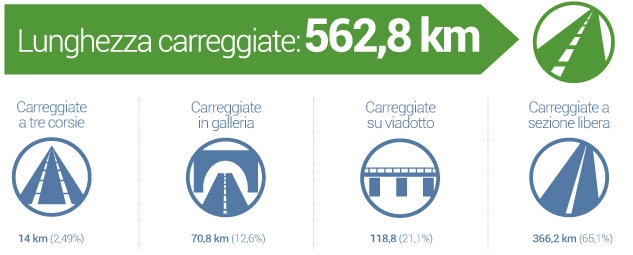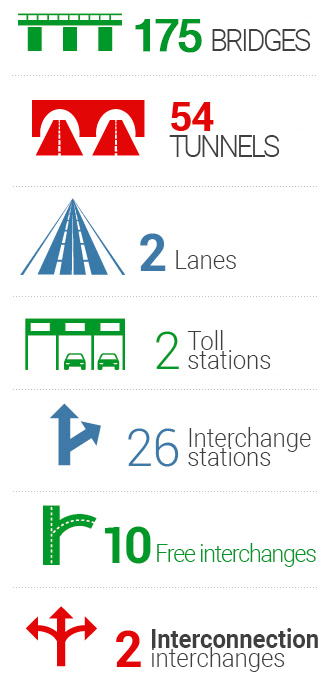The A24 and A25 highways, set in an extraordinary landscape, are a quick and convenient link connecting the A1 Autostrada del Sole highway to the A14 Adriatica highway. The A24 also offers the fastest and most direct connection to the city of Rome by penetrating, like no other highway, just a few kilometers away from the historic center. But above all, both offer the possibility of a journey to discover an extraordinary territory, the one between the region of Lazio and Abruzzo, involving 6 natural parks and the Gran Sasso massif.
The A24 freeway begins at Rome’s Tangenziale Est (Eastern Ring Road) at Tiburtina station, crosses the northeast quadrant of the capital to the intersection with the Grande Raccordo Anulare (Ring Road), and extends 281.4 km toward Teramo and Pescara. At the directional junction of Torano (the progressive Km 71 400) the network bifurcates into two branches: one continues toward L’Aquila-Teramo (A24) and the other toward Chieti-Pescara (A25).
The A24 ends at Teramo, at the 159.2 km mark, joining the SS 80 to Giulianova, while the 114.9-km-long A25 ends at Pescara, at the 186.4 km mark, connecting with the A14 Highway.
The route is characterized by 175 bridges and viaducts, with a total development of about 118.8 km: to understand the impressiveness of these structures it is enough to consider that some of these viaducts exceed 100 meters in height above ground level. Another element that contributes to the uniqueness of the two highways are the 55 tunnels encountered on the route, which, with a total development of about 70.8 km, represent 12.6 percent of the highway route: note that as many as eight of these tunnels have lengths varying between two thousand and ten thousand meters.
The entire highway network has 2 carriageways, each consisting of two lanes, running and overtaking, and a third emergency lane in open sections. In the urban section of Rome, near the junction with the Grande Raccordo Anulare, since 2014 the highway has been flanked by two coplanar dual carriageways for as much as 11 km, designed to separate long-distance traffic from the Capital’s heavy traffic, thus fluidizing transit.

The A24 highway also has a three-lane carriageway, for about 7 km, in the section between the Colledara junction and the entrance to the Gran Sasso Tunnel in the direction of L’Aquila, where the longitudinal gradient exceeds 5 percent. A three-lane carriageway is also present between the Via di Portonaccio junction and the Viale Palmiro Togliatti junction, both in and out of Rome, for a total of 3 km. On the network there are 2 barrier stations, 26 interchange stations, 10 free interchanges and 2 interconnection interchanges with the A1 and A14 freeways, under concession to Autostrade per l’Italia: the possibility of access is therefore quite facilitated by the short distance between one station and another, which on average is about 11 km.
With 28 toll booths, 12 service areas, and 6 parking areas, our highways are traveled by more than 152,000 vehicles with about 260,000 travelers per day.Therefore, all the activities carried out by Strada dei Parchi have as a priority objective to provide the best possible assistance in terms of safety, comfort and fluidity.
The A24 and A25 highways are equipped with:
3 Highway Safety Centers (C.S.A.) with 6 Maintenance Posts (Roma Est, Valle del Salto, L’Aquila Ovest, Colledara, Celano, Pescara);
4 Plant Cores and one monitoring center (CEM), operating 24 hours a day, for surveillance and maintenance of electrical and special plants (Roma Est, S. Rocco Power Plant, Carrito Power Plant, Gran Sasso Power Plant);
4 Toll Collection Tracts based in East Rome, Avezzano, Chieti and West L’Aquila, to which the 28 Stations report;
1 Operations Room, operating 24 hours a day, equipped with the latest technology for data collection and sorting of information and instructions, to operators and travelers. Visit the Operations Room
All of our personnel–from toll collection, the Operations Room, the Plant Monitoring Center and the Traffic Auxiliaries–operate on the highway 24 hours a day, in continuous rotating shifts.
View the complete list of facilities and services on Parks Road.







